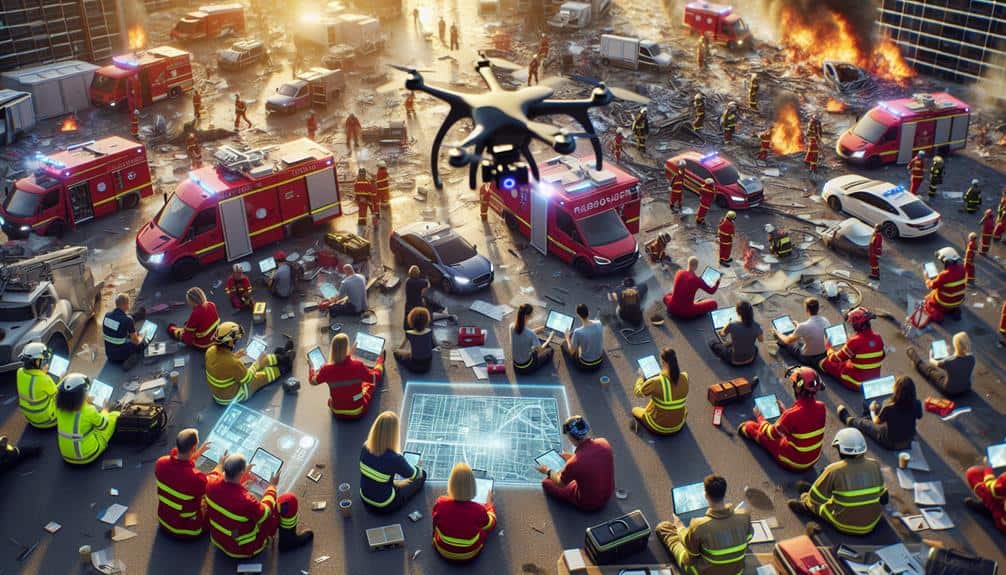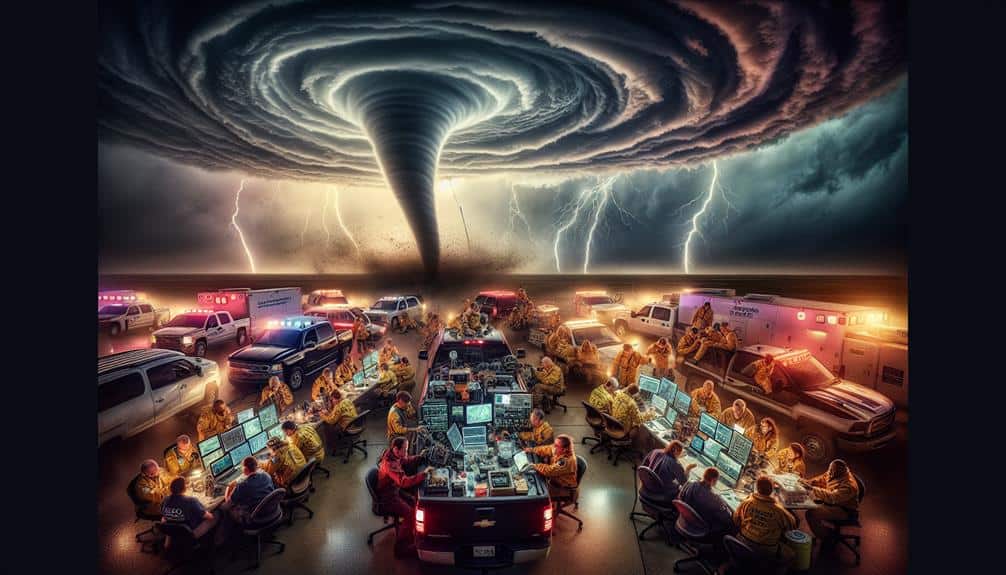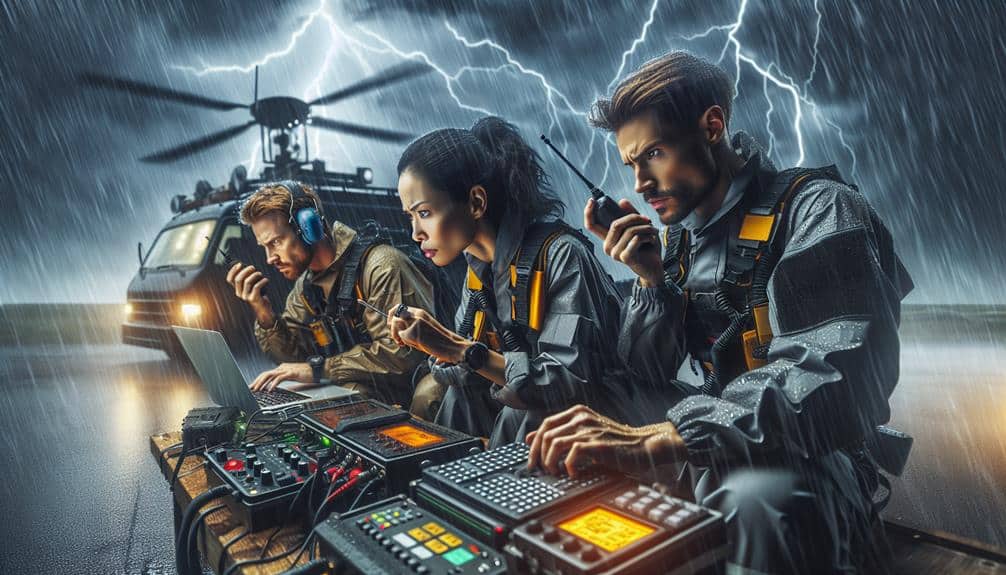We recommend five best practices for using drones in emergency response: first, establish pre-planned deployment protocols to guarantee swift deployment. Second, utilize real-time data collection to enhance situational awareness and agile decision-making. Third, strengthen communication channels to ensure smooth information flow and effective coordination. Fourth, prioritize drone safety by conducting thorough risk assessments and continuous monitoring. Finally, conduct post-operation analysis to evaluate performance and improve future operations. These steps help us respond more effectively to emergencies, and if we continue, we'll uncover deeper insights and strategies for efficient drone utilization.
Key Points
- Establish pre-planned deployment protocols to ensure rapid and efficient drone deployment during emergencies.
- Utilize live streaming capabilities to enhance situational awareness and agile decision-making.
- Integrate emergency alerts and cloud-based platforms for seamless and responsive communication.
- Conduct thorough risk assessments and implement safety measures to protect responders and civilians.
Rapid Deployment Strategies
To guarantee drones are swiftly operational during emergencies, we must establish pre-planned deployment protocols that facilitate immediate action. The success of rapid deployment hinges on efficient drone coordination and precise emergency mapping. By having a robust protocol in place, we make sure that drones aren't just dispatched quickly, but also directed to the most critical areas without delay.
Our first step involves setting up a centralized command system that oversees all drone operations. This system should coordinate with local emergency services, making sure seamless integration. We need to designate specific roles within our team, such as drone pilots, data analysts, and communication officers, to streamline the operation.
Next, emergency mapping becomes essential. We should pre-map potential disaster zones, highlighting key infrastructure and vulnerable areas. These maps must be updated regularly to reflect any changes in the landscape or urban development. By having these maps ready, drones can be directed with precision, avoiding unnecessary delays.
Additionally, maintaining a well-maintained fleet with fully charged batteries and pre-loaded software ensures that our drones are always ready for immediate deployment. It's crucial that our team conducts regular drills, simulating various emergency scenarios to test and refine our protocols. This proactive approach ensures we can respond swiftly and effectively when disaster strikes.
Real-Time Data Collection
Real-time data collection from drones provides crucial insights that can greatly enhance the effectiveness of emergency response efforts. With live streaming capabilities, we can monitor unfolding situations with unprecedented immediacy. This allows us to make informed decisions on the fly, deploying resources where they're needed most.
Aerial surveillance offers a detailed view of the affected areas, revealing details that ground teams might miss.
When we utilize drones for real-time data collection, we're not just gathering information—we're also increasing our situational awareness. We can track the movement of people, vehicles, and even environmental changes, ensuring our response remains adaptive and effective.
The immediacy of live streaming means that decision-makers have access to the most current data, reducing the risk of outdated information leading to suboptimal responses.
Our commitment to leveraging aerial surveillance means we can assess the scope of an emergency more quickly. By doing so, we can prioritize tasks, allocate resources efficiently, and ultimately save lives.
This technology empowers us to act swiftly and decisively, ensuring that our emergency response is both agile and well-informed. In the dynamic landscape of crisis management, real-time data collection is a game-changer.
Enhancing Communication Channels
Building upon the insights gained from real-time data collection, our next focus is on enhancing communication channels to ensure that information flows seamlessly among all stakeholders during an emergency. Effective communication is important, especially when lives are at stake. We need to guarantee that remote monitoring systems are robust and reliable. These systems allow us to track the drone's location, gather essential data, and relay it to command centers swiftly.
One way to enhance communication is by integrating emergency alerts into our drone operations. These alerts can notify ground teams, medical personnel, and other relevant parties immediately, ensuring everyone remains informed and coordinated. By leveraging cloud-based platforms, we can share real-time video feeds and data analytics with all stakeholders, regardless of their physical location.
Moreover, we should prioritize establishing redundant communication channels. This can include satellite communication, mobile networks, and dedicated radio frequencies. By doing so, we minimize the risk of losing contact during critical moments.
Ultimately, our goal is to create a responsive and adaptable communication framework. This will empower emergency response teams to act swiftly and efficiently, maximizing their ability to save lives and mitigate damage.
Ensuring Drone Safety
Ensuring the safety of drones in emergency response operations hinges on strict protocols and continuous monitoring. We must establish a detailed framework that includes safety measures and thorough risk assessment to guarantee our drones operate efficiently and safely. By doing so, we can maximize their potential without compromising the safety of responders and civilians.
First, conducting a thorough risk assessment before deployment is vital. This involves evaluating potential hazards, such as weather conditions, proximity to populated areas, and obstacles in the flight path. By identifying these risks early, we can develop strategies to mitigate them effectively.
To make our approach more relatable, let's break it down into these key components:
- Safety Measures: Implementing stringent pre-flight checks, including hardware inspections and software updates, to ensure drone reliability.
- Continuous Monitoring: Utilizing real-time telemetry and video feeds to monitor drone performance and surroundings, enabling quick adjustments to avoid potential hazards.
Post-Operation Analysis

After each mission, we must conduct a thorough post-operation analysis to evaluate drone performance and identify areas for improvement. This process begins with detailed data analysis. By examining flight logs, video footage, and sensor data, we can gain insights into how effectively the drones carried out their tasks.
We need to focus on performance evaluation to determine if the drones met mission objectives. Did they capture all necessary data? Were there any technical issues during the flight? By answering these questions, we can assess the reliability and efficiency of our drones in emergency scenarios.
Data analysis also helps us understand environmental factors that might've influenced drone performance. For instance, strong winds or signal interference could impact flight stability and data transmission. Identifying these variables enables us to adjust our strategies and equipment for future missions.
Post-operation analysis isn't just about the technology; it's also about our team. We should review our operational protocols and communication methods. Did we make timely decisions? Was information shared effectively among team members? By evaluating both drone performance and team dynamics, we ensure ongoing improvement and readiness for any emergency response.
Frequently Asked Questions
How Can Drones Be Used to Assess Environmental Damage After a Natural Disaster?
We can use drones for damage assessment after a natural disaster by leveraging aerial imaging and remote sensing. This allows us to quickly gather critical data for disaster response, ensuring accurate and timely situational awareness for effective action.
What Types of Drones Are Most Effective in Search and Rescue Missions?
For search and rescue missions, we find quadcopters and fixed-wing drones most effective. Quadcopters excel in tight spaces and urban areas, while fixed-wing drones cover expansive territories, aiding in coastal surveillance and forest mapping.
How Do Drones Help in Delivering Medical Supplies During Emergencies?
We see drones providing critical aerial support in emergency response by enabling remote monitoring and precision delivery of medical supplies. This technology guarantees rapid, accurate distribution, enhancing our situational awareness and overall efficiency during crises.
What Training Is Required for Drone Operators in Emergency Situations?
Did you know that 60% of emergency response teams use drones? We need extensive training on drone regulations, emergency response protocols, and situational awareness to guarantee we can effectively and safely deploy drones during crises.
How Do Drones Assist in Managing and Controlling Crowd Movements During Large-Scale Events?
Drones assist in managing and controlling crowd movements by providing real-time crowd monitoring and event surveillance. They enhance safety and planning by offering aerial views, identifying bottlenecks, and ensuring swift responses to potential issues.


